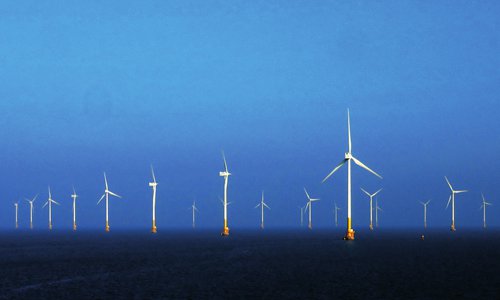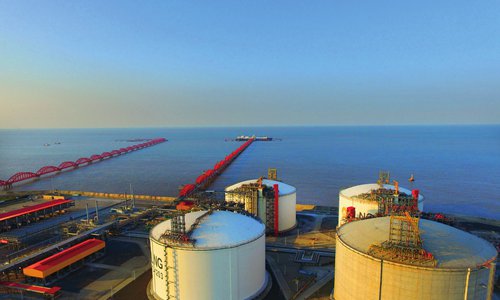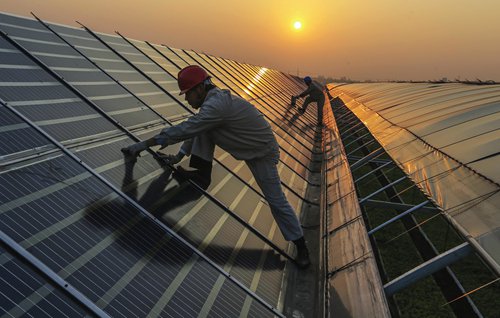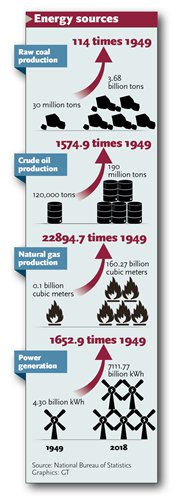70 years of development in China’s growing energy sector
Source:Global Times Published: 2019/9/24 17:43:40
Nation looks to bigger, cleaner and more accessible alternatives to coal and oil

The Donghai Bridge Wind Farm in Shanghai was the first offshore wind farm in China, and began operation in June, 2010. Photo: VCG

A view of the PetroChina Jiangsu LNG receiving station at the Yangkou Port in Nantong, East China's Jiangsu Province. The station ranks first in terms of receiving frequency and capacity of LNG container ships in China. Photo: VCG

A worker inspects the newly installed photovoltaic panels on the roof of a greenhouse in Taixing, East China's Jiangsu Province in 2016. Photo: VCG
Summary:China's energy production level began low in 1949, and the relationship between supply and demand was tense with serious structural problems. Seventy years later, with the rapid development of China's economy and the significant increase in social productivity, China's energy sector has undergone unprecedented changes. Energy consumption has continued to upgrade, and historical improvements have been achieved.
In the future, the energy structure will be further optimized, tilting towards clean and renewable energy sources.
The highlights of 70 years of energy development, according to Lin Boqiang, director of the China Center for Energy Economics Research at Xiamen University, are the booming volume of the energy sector, the mass accessibility of electricity and the structural transformation towards cleaner energy.
China's energy base was weak, and from the 1950s to the 1970s, from the first Five-Year Plan to the fifth, the government made specific arrangements for the development of power, coal, oil and other energy industries. It also proposed energy-saving policies for electricity, coal and oil.
According to Lin, these polices became the foundation of the structural reform of China's energy sector in later years.
Since China's reform and opening up began in 1978, China has paid more attention to the quality and efficiency of energy development. From the sixth Five-Year Plan to the 10th, China gradually proposed the improvement of economic and energy efficiency. Energy saving, development and structure optimization were treated as priorities, while research and investment were strengthened for energy technology and the improvement of energy efficiency.
"In the early years, the main challenge for China in terms of energy was a lack of energy resources," Lin said, "so the energy structure was cruder. Later, more efforts were put into how to limit impacts on the environment."
Since the beginning of the 21st century, China has been facing increasingly constrained resources and prominent ecological and environmental problems.
The country has been adhering to the basic national policy of conserving resources and protecting the environment, and has been actively transforming its mode of economic development with more energy conservation efforts. Energy consumption per unit of GDP was included as a binding indicator of economic development in the 11th, 12th and 13th Five-Year Plans.

Graphics: GT
Increased capacityIn the 70 years since 1949, with the rapid development of China's economy and the continuous improvement of people's living standards, energy consumption has demonstrated relatively rapid growth.
In 1953, China's total energy consumption was only 500 million tons of standard coal. In 2018, it reached 4.64 billion tons - an increase of 84.8 times, at an average annual growth rate of 7.1 percent.
"The sheer size increase in the energy sector is remarkable worldwide," Lin told the Global Times. "Now China is the country with the biggest generation power for electricity. Behind the rise in energy production is the increasing demand from the rising Chinese economy."
Energy consumption per capita has also significantly improved. In 1953, China's per capita energy consumption was only 93 kg of standard coal.
In 2018, it reached 3,332 kg - an increase of 34.8 times compared to 1953, with an average annual growth rate of 5.7 percent.
According to Lin, this remarkable achievement is not only due to the energy sector's increased volume, but is also due to the improved accessibility of energy.
"The accessibility of electricity in China almost reached 100 percent," Lin said, "and the mass accessibility of energy is key to power any economy. Among developing countries globally, this is an extraordinary achievement. Worldwide, there are still 1 billion people that do not have access to electricity, including 100 million in India."
Alongside increased energy consumption is the optimization of energy consumption. Over the last 70 years, with the continuous improvement of China's energy science and technology innovation, energy technology equipment has improved in leaps and bounds. Automation, artificial intelligence and digitalization have promoted the optimization of energy systems, and the energy efficiency level has been significantly improved. Energy consumption per unit of GDP in 2018 was 43.1 percent lower than 1953, with an average annual decline rate of 0.9 percent.
In terms of energy consumption units of per unit of GDP (GDP is calculated at the price level of 2018), unit energy consumption gradually increased from 0.91 tons of standard coal per 10,000 yuan ($1407) in 1953 to 2.84 tons in 1960, and then gradually declined. After gradually rising in the 1970s, the number showed a steady declining trend. In 2018, it dropped to its lowest level of 0.52 tons. Overall, the figure fluctuated significantly before China's reform and opening-up, rising most years, and was in steady decline following the reform and opening-up.
Achievements in energy saving
Since its 11th Five-Year Plan, China has attached great importance to energy conservation and consumption reduction, and has successively introduced a number of relevant policies to strengthen energy conservation and emissions reduction. Systems, mechanisms and legal regulations were established to promote energy conservation in key areas such as construction and transportation.
Through measures such as reducing consumption, speeding up industrial adjustment, eliminating backward production capacity and optimizing energy structure, China's energy development has entered a new stage, with excellent results in energy conservation and consumption reduction.
The first result was the shift in energy production from traditional to new energy sources. Since its 11th Five-Year Plan, China's energy production underwent tremendous changes. The energy structure was transformed to become more diversified and cleaner.
The growth rate of traditional energy production, such as the production of raw coal and crude oil, has slowed down remarkably and its proportion in the energy sector has dropped sharply. From 2005 to 2018, the annual output of raw coal increased by 3.5 percent, which was 4.5 percentage points lower than the average annual growth rate from 1949 to 2005. The proportion of crude oil in overall energy consumption in 2018 was 8.1 percentage points lower than in 2005.
In recent years, China has been working hard to contain the impact of traditional fuels on the environment, Lin said, and the annual consumption of oil and coal is under strict control.
Clean energies such as natural gas, hydropower, nuclear power and new energy are growing rapidly with increasing proportions in overall energy consumption.
Natural gas production is growing at an average annual rate of 9.5 percent, with its proportion increasing 2.6 percentage points.
The annual output of electricity and other energy sources is at an average rate of 10.2 percent, and its proportion has increased by 9.6 percentage points.
Energy-saving efforts have also yielded excellent results. Since the 11th Five-Year Plan, under vigorous policies to promote energy conservation and consumption reduction, China's energy consumption per unit of GDP has shown a downward trend as a whole, with a cumulative decrease of 41.5 percent from 2005 to 2018.
During the 13th Five-Year Plan period, energy consumption per unit of GDP was 11.4 percent lower in 2018 than in 2015. In 2020, the number is likely to drop 15 percent from 2015.
"This is the way forward," Lin said.
"As the largest developing country, China is also taking on more responsibility in terms of emissions and environmental protection. Enhanced energy structure and a continued shift towards clean energy will be evolving direction in the future."